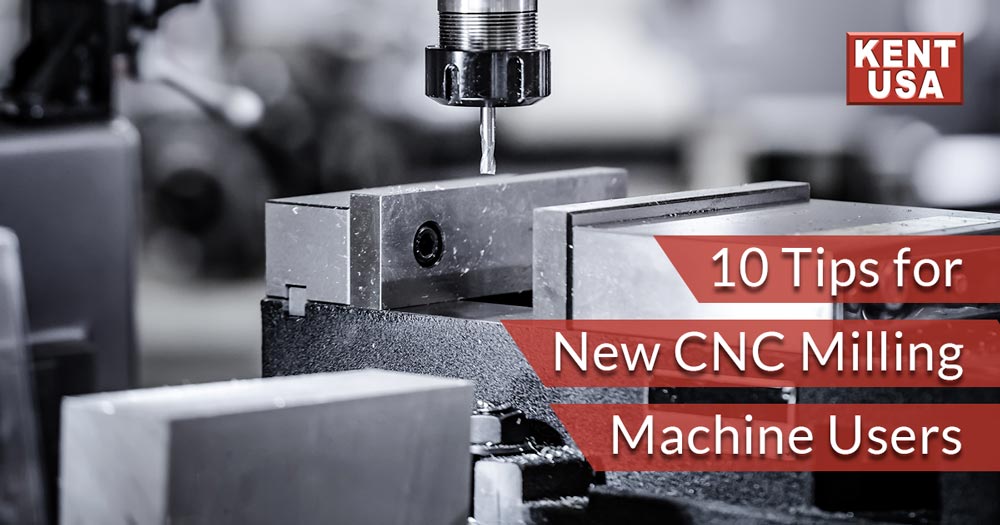10 Tips for New CNC Milling Machine Users
You’ve just purchased a CNC milling machine but have very little knowledge about CNC. You’re excited about beginning your first new project like making bicycle hubs, clock parts or maybe machining your own guitar! With CNC, you can build practically anything, and all it takes is a little time, effort and practice to become successful in building your projects.
However, you’re just starting out, so before you begin tackling those larger, more complex projects, we have some helpful suggestions to get you going. If you have an idea in mind on how to carve-out your first CNC parts, begin with our 10 helpful tips. You’ll get a lot of information you need on how to proceed with your first milling project.
These 10 tips will help maximize your efforts in being successful with your CNC milling projects.
1. Buy some good quality cutters
You get what you pay for so avoid purchasing cheap, low-quality cutters. You don’t necessarily have to pay an arm and a leg for top-of-the-line cutters, just get some good cutters from a well-known brand with reasonable prices. This will make a huge difference in producing quality parts and will eliminate tons of unnecessary problems that can occur by using cheaper tools. For example, carbide cutters will last longer. You’ll want to pick-up a few different sizes, such as ½” and ¼”, etc. Be sure to wear your safety goggles because these cutters will break. It’s also a good idea to buy a complete drill assortment.
2. Purchase a quality vise, a set of parallels and a clamping kit
Workholding is key to keeping that part in place. You’ll want a good quality vise that will last for years. You don’t want your part to shift out of position.
A good clamping kit will mount your vise to the T-slots of your table. And finally, get a decent set of parallels to keep your workpiece parallel or raised evenly for the cutting tool/spindle to pass over.
3. A misting set up for coolant is essential to prevent chip buildup.
There are two types: the siphon-based and micro-drop. The siphon system completely atomizes the coolant into an aerosol, which can be messy. The micro-drop system pressurizes the coolant, keeping the coolant and air in separate chambers until they hit the tip of the tool. With the micro-drop system, the coolant vaporizes when it hits the workpiece. It’s much more efficient and not as messy. A good misting system will help to prevent chip buildup.
4. Learn to use Manual Data Input (MDI)
You’ll save a lot of time and increase your productivity by using the Manual Data Input (MDI), which is accessed via the MDI keypad on your CNC machine’s control panel. It requires very little learning and will save a lot of time. You can set some basic g-codes and adjust your X, Y and Z coordinates, move your axes, and the machine will move rapidly after you’ve inputted the information. This rapid movement of the machine is referred to as “Rapids.” You want that cutter to go where you want it to go.
5. Purchase a feeds and speeds calculator for greater accuracy
Accuracy is top priority when making your cuts. To ensure this, you’ll want to use a feeds and speeds calculator to make sure your spindle speeds and feedrate are precise from the very first cut.
CNC machining is a different ballgame from manual machining and it’s very important to get your feeds and speeds correct, right from the start. So, a feed and speeds calculator is essential.
6. Buy a touch tool measuring device to get accurate measurements of your Z-heights. Also, purchase an Edge Finder and use it to set your part zeros.
It’s important for the machine to know where the tip of your tool is for accuracy. The Touch Tool will tell your machine what your tool length is and tell you where the tip is in Z. To set the position of X and Y an Edge Finder is essential to have. You will be using these measuring tools to set your zeros after inserting your material in your vise and inserting a tool in the spindle. Edge Finder is available as an option in Kent USA’s best selling CNC knee mill, KTM-4VKF-E. Check out our Edge Finder tutorial video to see how it works.
7. Tram your mill and vise for accurate cuts
Tram is the squareness of your mill head to the table. There is a tram parallel to the x-axis and a tram parallel to the y-axis. It’s important to check the tram on your mill whenever you begin a new project. If you want accurate cuts and the best finishes, your mill needs to be in tram. It’s a basic skill every machinist needs to learn. Also, be sure to tram your vise so the jaws are aligned properly with one axis or the other.
8. Stay away from stainless steel. Begin with aluminum, brass and mild steel.
Now you’re ready to begin making some cuts. The first seven tips have now gotten us to this point and we are ready. When first starting out, you want to avoid using harder materials like stainless steel for your first cuts. It’s important to feel confident in using the softer materials and mastering cuts while reducing the likelihood of breaking or causing premature wear to your cutters. You also want nice finishes. There are many sources on the web for “Mild Steel.”
9. Use aluminum material and make a square block of material and a few sets of step jaws.
Using your saw, cut some pieces of material that are slightly oversized that will serve as vise jaws. Cut the stock slightly oversized. The next step is to square these blocks. Squaring means you’ll make a series of milling cuts until all sides are parallel or perpendicular to each other, making the workpiece “square.”
After you’ve squared the material, you will cut it to size by continuing to mill it until it fits your vise jaws perfectly. (You’ll need two square pieces, one for each jaw.) Then, drill and countersink the mounting holes. And lastly, mill a step along each jaw. If you wish, you can use this step instead of parallels when placing the material into the vise.
10. Step-up to CNC
a. CAD/CAM
You’ve done the basics. Now it’s time to learn and use g-code on your CNC. But first, you’ll need to learn and become proficient in CAD/CAM. It’s not an easy program to learn but well-worth the time and effort you’ll invest. You can take courses at a community college. Or, perhaps get help from someone you know. There is also help from the internet with tons of videos available to learn from. There are also online forums where people go to get help with these programs.
You can start by learning CAD. Once you get to the point where you’ve drawn a number of parts, you can then start learning CAM. It will be easier and less overwhelming to tackle one of these programs at a time. As a beginner, you’ll want to learn the quickest path to making some parts. Then, as time goes by, you can consider upgrading as your needs require. Kent USA milling machines can be factory installed with Acu-rite MillPwr G2 controls.
b. Conversational CNC (Delaying the need for CAD/CAM for awhile)
If you’re in a hurry or don’t have the time right now to learn CAD/CAM and want to make simple parts, Conversational CNC makes it possible to cut your workpieces more simply and easily. Just pick an operation and a popup menu will ask you some questions. Then, you press the Insert button and you now have your g-code! It’s still very important to learn CAD/CAM, but Conversational CNC makes it possible to machine simple parts before learning CAD/CAM.
Congratulations on Learning Your Basic CNC Skills!
Now you’ve learned some of the basics to begin your projects with confidence. And when you’ve learned and mastered CAD/CAM, you can become very proficient in all your machining tasks.
Share this article:


